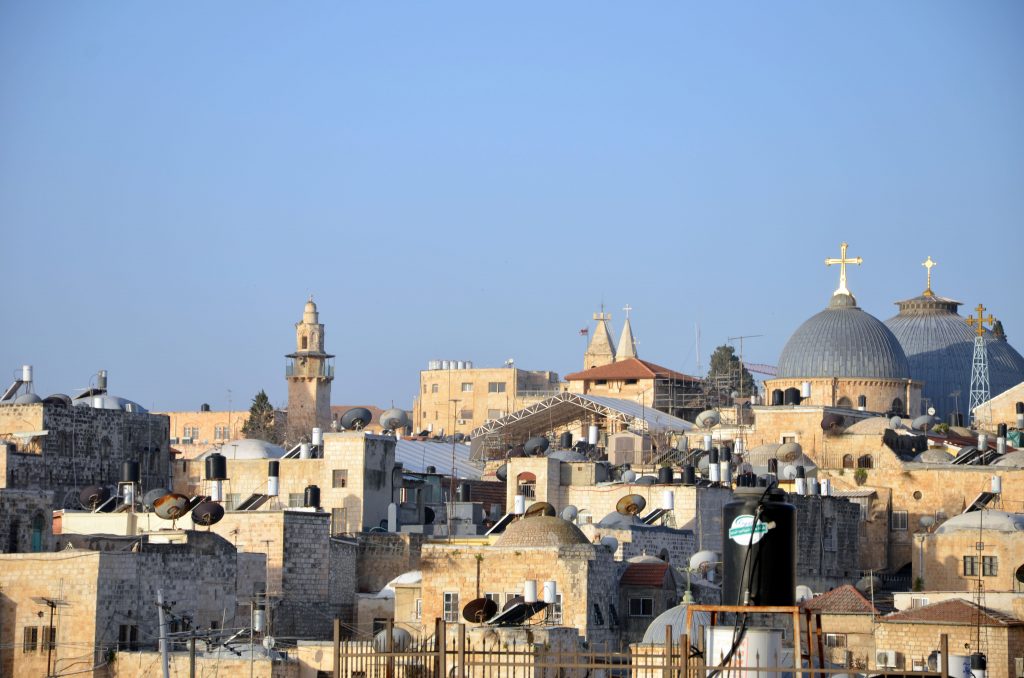
By Rachel Curry
Profound, deeply moving and awe inspiring are the words Bateman parishioner Angela McCarthy uses to describe her recent experience of celebrating Easter in the Holy Land.
Dr McCarthy was invited to Jerusalem to direct the music for this year’s Easter Triduum at the Ecce Homo convent, run by the Sisters of Notre Dame de Sion, and has shared her story in a two-part feature for The eRecord.
After arriving in Jerusalem, Dr McCarthy and fellow Bateman parishioner and musician Brendan D’Sa participated in a Passover and Easter course at the Centre for Biblical Formation, before attending a Palm Sunday procession down the Mount of Olives.
We pick up their journey on Holy Thursday, which they celebrated in the Basilica of Ecce Homo, containing arches built by Emperor Hadrian in about 130AD.
Dr McCarthy said the basilica was traditionally remembered as the site where Pontius Pilate tried Jesus and declared “Ecce Homo”, translated as “Here is the man!” (John 19:5).
“It is a beautiful liturgical space with extraordinary acoustics (like nothing I have ever experienced in Australia) and holds around 200 people,” she said.
“Since there were a considerable number of priests participating in the Ecce Homo and Tantur Ecumenical Institute biblical programs, they all concelebrated for this very special night.
“Afterwards, we walked down into the olive grove at the bottom of the Mount of Olives, which is custodian of the story of Jesus’ betrayal and arrest.
“The garden was lit with green lights and there were many people there just silently praying around the garden and in the Church of All Nations next door.”
The group finished the night by walking to the Church of St Peter in Gallicantu, which covers excavations of the house of Caiaphas, where Jesus was taken to be tried by the Sanhedrin.
They continued to retrace Jesus’ steps on Good Friday, which was celebrated in the Lithostrotos – the excavations under Ecce Homo that date back to the first century.
Dr McCarthy said the paving stones formed part of the Antonia Fortress and could have been where Jesus was tortured and held the night before He died.
“It is a very awkward liturgical space but the sense of the sacred was so profound that we found ourselves deeply moved,” she said.
“Careful ushering meant that the movement of around 150 people was gently paced and, as I venerated the cross, I was moved to tears.”
They returned to the Basilica of Ecce Homo the next day to celebrate the Easter Vigil, which began with a musical procession from the roof to the sanctuary.
The liturgy also incorporated singing and dancing, which Dr McCarthy described as “a rich experience of the Word”.
“For the final hymn, Sing With All the Saints in Glory, the choir went to the loft to stand alongside the ancient organ,” she said.
“What was most moving about the final song was the extraordinary sound coming from the nave of the basilica below us, as hearts and voices lifted into the joy of Easter.”
Easter Sunday was a quieter affair, with the group celebrating Mass at dawn on the roof of Ecce Homo, overlooking Jerusalem.
They were joined by the French-speaking Chemin Neuf community and Dr McCarthy said it was “a gentle celebration with a touch of awe”.
On Easter Monday, Dr McCarthy and Mr D’Sa attended Mass in the Church of the Resurrection/Holy Sepulchre, known as the holiest of all Christian sites.
Historians consider this as the place where Jesus was crucified, known as ‘Calvary’, as well as where Jesus’ tomb was cut from the rock.
“Over two millennia, this church has become encrusted with so many different aspects of the Christian tradition that it is quite confusing,” Dr McCarthy said.
“Custody is shared by different Christian groups but principally by the Greek Orthodox, then the Armenian Orthodox, Roman Catholics and the Egyptian Copts, Syriacs and Ethiopians.”
The pair concluded their trip by visiting a number of other holy sites, including St Anne’s Church, where the birthplace of Mary has been venerated since the third century, and the Upper Room, believed to be the site of the Last Supper.
Reflecting on the experience, Dr McCarthy said it would take time before she could fully appreciate the opportunity she had been given to “live in the land, with the people, and feel the Word of God in a new and rich way”.